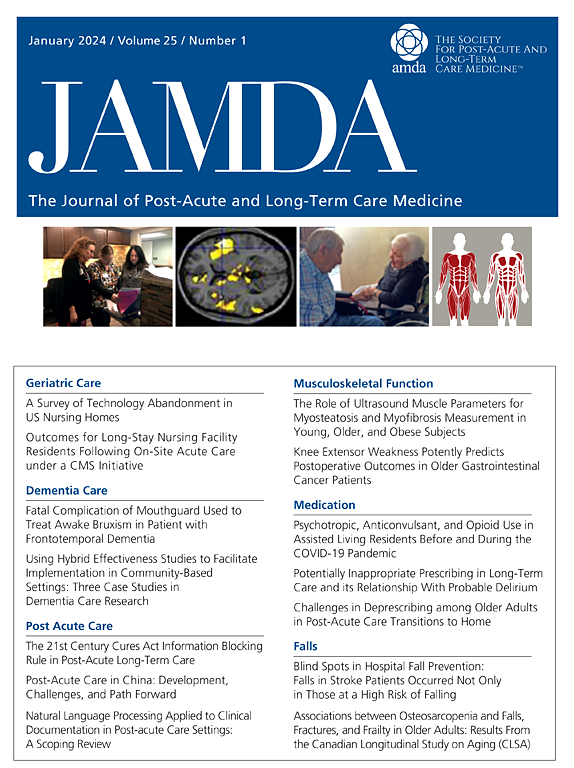Prognostic Value of Sarcopenia Definitions and Outcomes Consortium Criteria in Older Patients with Heart Failure
IF 4.2
2区 医学
Q2 GERIATRICS & GERONTOLOGY
Journal of the American Medical Directors Association
Pub Date : 2024-11-12
DOI:10.1016/j.jamda.2024.105350
引用次数: 0
Abstract
Objectives
The Asian Working Group for Sarcopenia in 2019 (AWGS 2019) emphasized muscle mass measurements. In contrast, the Sarcopenia Definitions and Outcomes Consortium (SDOC) prioritizes functional strength and mobility. Therefore, this study aimed to compare the prognostic utility of the SDOC and AWGS 2019 criteria for all-cause mortality in older patients with heart failure.
Design
A post hoc analysis of the Prevalence and Prognostic Value of Physical and Social Frailty in Geriatric Patients Hospitalized for Heart Failure (FRAGILE-HF) study, a prospective, multicenter, observational study.
Setting and Participants
Patients aged ≥65 years hospitalized for heart failure across 15 hospitals in Japan.
Methods
Sarcopenia was diagnosed according to the AWGS 2019 and SDOC definitions. According to the SDOC criteria and by integrating insights from previous research, patients were categorized into nonsarcopenia, possible sarcopenia, and sarcopenia groups. The primary outcome was 2-year mortality.
Results
Of the 1282 study patients, possible sarcopenia and sarcopenia were diagnosed in 357 and 786 individuals, respectively. Kaplan–Meier analysis revealed a significant difference between the groups. Adjusted Cox proportional hazards analysis indicated a significant stepwise association between sarcopenic status and mortality risk (possible sarcopenia: hazard ratio, 1.22; 95% CI, 0.66–2.28; P = .525; sarcopenia: hazard ratio, 1.89; 95% CI, 1.08–3.34; P = .027). When sarcopenia defined by the SDOC and AWGS 2019 criteria was added to the model incorporating conventional risk factors, no significant difference was observed in the prognostic capabilities between the 2 models (net reclassification improvement, −0.009; 95% CI, −0.193 to 0.174; P = .920, with areas under the receiver operating characteristic curve of 0.697 for SDOC and 0.703 for AWGS 2019; P = .675).
Conclusions and Implications
Among older patients with heart failure, the SDOC criteria for sarcopenia diagnosis are useful for risk stratification and provide prognostic capabilities equivalent to those of the AWGS 2019 criteria.
Sarcopenia 定义和结果联盟标准对老年心力衰竭患者的预后价值
目标:2019 年亚洲 Sarcopenia 工作组(AWGS 2019)强调肌肉质量测量。相比之下,"肌肉疏松症定义与结果联盟"(SDOC)则优先考虑功能强度和活动能力。因此,本研究旨在比较 SDOC 和 AWGS 2019 标准对老年心衰患者全因死亡率的预后效用:FRAGILE-HF研究是一项前瞻性、多中心、观察性研究:环境和参与者:日本 15 家医院中因心力衰竭住院的年龄≥65 岁的患者:根据 AWGS 2019 和 SDOC 的定义诊断 "肌肉疏松症"。根据 SDOC 标准并结合以往研究的见解,将患者分为非肌肉疏松症组、可能肌肉疏松症组和肌肉疏松症组。主要结果为2年死亡率:结果:在 1282 名研究患者中,分别有 357 人和 786 人被诊断为可能的肌肉疏松症和肌肉疏松症。卡普兰-梅耶分析显示,两组之间存在显著差异。调整后的考克斯比例危险分析表明,肌肉疏松状态与死亡风险之间存在显著的逐步关联(可能的肌肉疏松症:危险比为 1.22;95% CI 为 0.66-2.28;P = .525;肌肉疏松症:危险比为 1.89;95% CI 为 1.08-3.34;P = .027)。当将SDOC和AWGS 2019标准定义的肌肉疏松症加入到包含常规风险因素的模型中时,两种模型的预后能力没有明显差异(净再分类改善率为-0.009;95% CI为-0.193至0.174;P = .920,SDOC的接收者操作特征曲线下面积为0.697,AWGS 2019的接收者操作特征曲线下面积为0.703;P = .675):在老年心力衰竭患者中,SDOC 肌肉疏松症诊断标准有助于进行风险分层,其预后能力与 AWGS 2019 标准相当。
本文章由计算机程序翻译,如有差异,请以英文原文为准。
求助全文
约1分钟内获得全文
求助全文
来源期刊
CiteScore
11.10
自引率
6.60%
发文量
472
审稿时长
44 days
期刊介绍:
JAMDA, the official journal of AMDA - The Society for Post-Acute and Long-Term Care Medicine, is a leading peer-reviewed publication that offers practical information and research geared towards healthcare professionals in the post-acute and long-term care fields. It is also a valuable resource for policy-makers, organizational leaders, educators, and advocates.
The journal provides essential information for various healthcare professionals such as medical directors, attending physicians, nurses, consultant pharmacists, geriatric psychiatrists, nurse practitioners, physician assistants, physical and occupational therapists, social workers, and others involved in providing, overseeing, and promoting quality

 求助内容:
求助内容: 应助结果提醒方式:
应助结果提醒方式:


